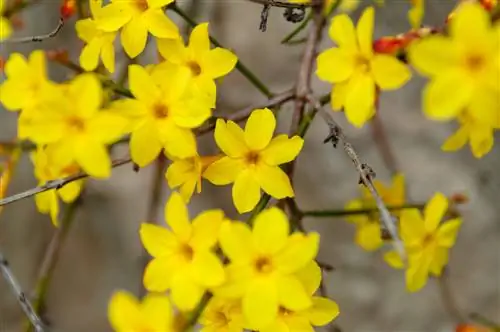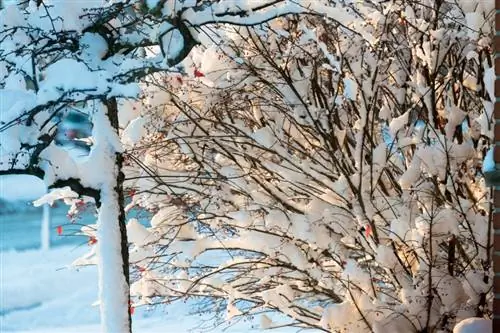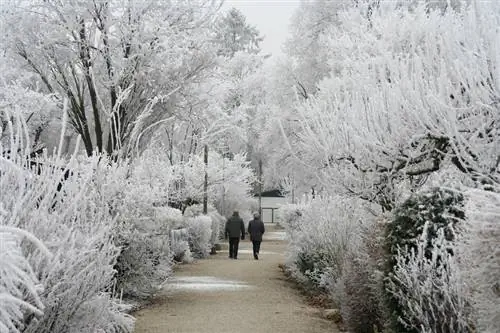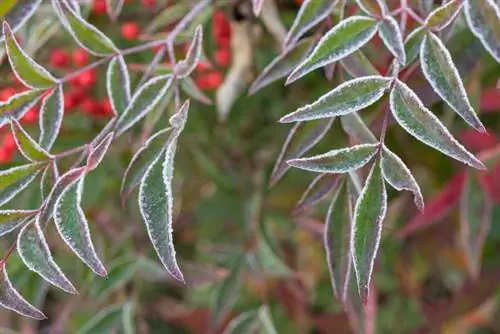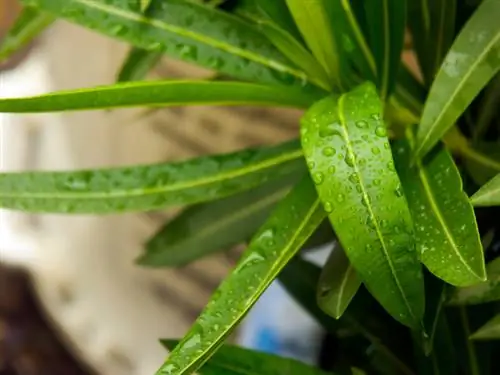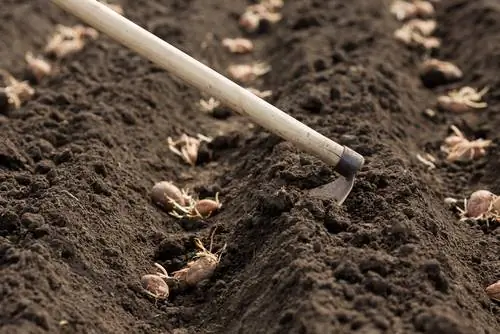- Author admin [email protected].
- Public 2023-12-16 16:46.
- Last modified 2025-01-23 11:21.
Winter jasmine brings the first blooms in the garden before snowdrops and crocuses. The shrub, which comes from northwestern China, also offers unimagined design possibilities thanks to its diverse growth characteristics.
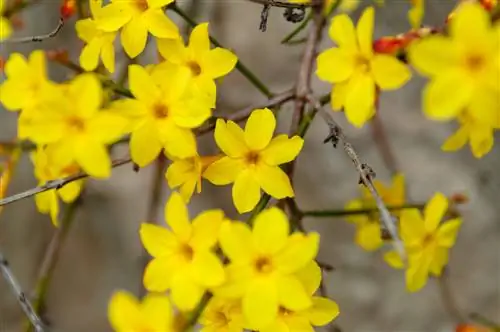
What characterizes winter jasmine?
Winter jasmine (Jasminum nudiflorum) is an attractive, hardy shrub that impresses with yellow, scentless flowers in winter. It prefers sunny to partially shaded locations with calcareous, permeable soils and is ideal for hedges, green walls or as a ground cover. Regular pruning promotes growth and flower formation.
Origin
In contrast to some ornamental plants commonly called 'jasmine', the winter jasmine is a real jasmine - so it actually belongs to the genus Jasminum. His species has the suffix nudiflorum, which in one of its German names is also literally translated as “naked-flowered jasmine”.
Its native range is the rocky highlands in the northern and western areas of China, where it inhabits low-vegetated slopes and ravines with harsh weather conditions. It is therefore naturally very tough and can withstand extreme heat and cold as well as harsh winds. In addition, despite its origins being far from civilization, it is very urban and accepts exhaust-heavy air in large cities without complaint. Therefore, it is also a perfect candidate for front garden decoration of houses on large streets.
Winter jasmine has been widely used in our country since it was introduced from China in the 19th century. You can see it in many gardens and it has long been released into the wild in parts of Central Europe.
Growth
Winter jasmine also has amazing things up its sleeve when it comes to growth. In gardens it is usually seen in a very unspectacular, shrubby habit in bordering hedges. As a free-growing shrub, it grows up to 2 meters high and around 3 meters wide. Its square, sparse, tough branches grow arched and overhanging and can become somewhat sprawling as the plant ages. They are initially green, but very quickly become woody and turn brown.
Winter jasmine grows very slowly in the first two years, but then grows even more intensively.
Winter jasmine can also be cultivated in completely different ways. On the one hand, thanks to its broad growth and long, rootable branches, it can be used as a great ground cover if you train it appropriately.
You can also use it to add greenery or flowers to walls and house walls. The winter jasmine is a spreading climber and can also climb vertically with a trellis. In this cultivated form it can also reach heights of up to 5 meters.
Growth characteristics at a glance:
- Long, square, sparse branches
- Shoots initially green, then quickly woody and turn brown
- First slower, then faster, somewhat sprawling growth
- Twigs can root: therefore also suitable as ground cover
- Spreading climber, therefore can also be used for wall greening with a climbing aid
leaves
On the branches, the jasmine forms pinnate leaves in an opposite arrangement, each with three small, dark green, shiny individual leaves. These have an egg-shaped, entire-rimmed shape about 1 to 3 cm long. They are summer green, so they are shed in winter.
Bloom
The flowering is of course the highlight of winter jasmine - after all, it appears unusually early and also gave the shrub its name. They are formed individually directly on the armpits of the previous year's branches and literally cover them with their yellow pile.
The flowers are very similar to those of forsythia in size, shape and color, but they have more, more precisely five to six, petals, which are also rounder and not as long. There are also only two stamens. In contrast to most other species of the genus, the flowers of winter jasmine do not develop a scent.
Flower characteristics in keywords:
- Yellow, standing alone
- 5 to 6-fold
- No fragrance
Flowering time
Winter jasmine also has the early flowering period in common with forsythia, although it occurs much earlier. If the weather is mild, they can radiate their fresh yellow in the garden as early as the end of December. The flowers also last a long time, until April - unless there is another strong frost by then, then they can freeze, but often grow again.
To remember:
- Flowering time can begin as early as the end of December if the temperatures are mild
- May remain in place until April
- Freezing possible in severe frost
Fruit
Winter jasmine almost never produces fruit in Central European latitudes. When they appear, they appear as egg-shaped berries about 6 millimeters long and about 3 to 4 centimeters in diameter.
Location
As far as location is concerned, winter jasmine is extremely undemanding in many respects. Since its natural habitat involves fairly harsh weather conditions, it can cope with many extremes such as intense heat and sunlight, frost and gusty winds. In terms of light, it should be in a sunny position, but it also thrives in partial shade. It also has few demands on the soil - although it prefers a relatively nutrient-rich, freshly moist and rather permeable planting soil, it also grows without any problems in poor, sandy soil. In terms of pH value, he prefers it more chalky.
To remember:
- Winter jasmine very undemanding in terms of location
- Tolerates high heat and sunlight, frost and strong wind
- Light: sunny to partially shaded
- Soil: rather nutrient-rich, chalky, moist and permeable
- But also grows in poor soil
Planting time
It is best to plant a winter jasmine in early spring to give it the opportunity to establish itself well over the warmer half of the year. The same applies if you want to grow winter jasmine in a bucket. In this case, planting in autumn is also possible. Winter jasmines planted outdoors should be protected from severe frost in the first winter with fir branches.
Planting spacing
If you want to incorporate the winter jasmine into a hedge, for example together with other deciduous hedge plants such as privet or hornbeam, you should allow a distance of at least one meter to the sides.
If you want to let it grow up a house wall, you only need to keep it about half a meter away from any neighboring plants, as the focus here is on height growth.
Pouring
As a rule, you do not need to water the winter jasmine separately. Due to its rough habitat, it has developed a largely self-sufficient way of life and is self-sufficient in many respects. However, it is advantageous if it is planted in soil that is already evenly moist.
Fertilize
Winter jasmine also does not need any additional nutrients. If you want to do something good for it, you can give it a little compost or a high-potash liquid fertilizer in the spring. In any case, its soil should be amended with compost when planting.
If you keep the winter jasmine in a bucket, fertilizing it with compost or liquid fertilizer is of course a little more justified because of the smaller substrate volume. If you value strong flowering, definitely use fertilizer containing phosphorus and potash. Nitrogen-containing, growth-promoting fertilizers are not suitable for winter jasmine simply because of its low leaf mass.
To remember:
- Winter jasmine generally does not need fertilization
- If necessary, fertilize with a little compost or potash-oriented liquid fertilizer, especially when grown in containers
Cutting
Winter jasmine is characterized by a fairly sparse growth pattern - and with increasing age also by a rather brisk growth rate. If you don't want it to get out of hand and appear unkempt, regular trimming is essential. However, if you start right from the start, nothing will stand in the way of an attractive, well-formed shrub.
Radical pruning of older specimens
Winter jasmine is extremely tolerant of cutting. This means that even neglected older specimens, which have long been woody in the center and only sprout green at the outer branch ends, can be easily rejuvenated by radical pruning. They sprout again reliably and develop a completely fresh, compact appearance again.
Regular topiary
Otherwise, annual pruning in spring directly after flowering is recommended. This promotes vital growth and good flower bud formation until winter.
Boundary cutting for ground cover crops
If you cultivate winter jasmine as a ground cover, you have to keep it under control a little more due to its intensive desire to spread. In most cases, it's not just shortening the shoots after flowering that helps - due to the strong tendency to root, you usually also have to pull out excessively long shoots.
Cutting rules at a glance:
- Winter jasmine is generally very easy to cut
- sparse growth requires regular pruning
- Older, neglected specimens can easily be cut back radically
- Make regular topiary cuts in spring after flowering
- When cultivated as a ground cover, very close pruning care is necessary
Propagate
The winter jasmine has a he althy instinct for self-preservation, which can be seen in its intensive rooting practice. This of course makes it easier for you as a hobby gardener to propagate it. The best way to do this is to simply use the cutting or lowering method.
offshoot
For an offshoot, simply cut out a young, trained shoot that is beginning to woody from the bush in spring or summer. To speed up rooting, it is best to make a light, not too deep, wound cut in the lower part to be planted.
Place the prepared cutting in a container with potting soil and, if possible, cover it with foil to create a consistently moist microclimate. Keep the growing container bright and warm. The young plant is ready to be planted after just a few months, but it is better to wait until later spring in the following year.
Lowers
Winter jasmine forms itself readily, so all you have to do is help yourself. Even if you keep it as a hedge shrub, its overhanging branches can suddenly root in the surrounding soil. When it comes to ground cover crops, the selection of rooted sinkers is of course even larger - here they become more of a nuisance and have to be constantly decimated.
If there is no acute rooted sinker, simply lead a branch with the green part downwards and fix it in the ground with a metal hook.
You can cut off a sufficiently rooted sinker with a spade and replant it elsewhere. However, the rooting should have lasted throughout the spring and summer period.
Diseases
Winter jasmine is pleasingly robust against diseases. As a rule, you don't have to worry about him.
Powdery mildew
It can also be affected by powdery mildew if necessary. Unusually, this fungal disease does not develop when the weather is too wet, but rather when the weather conditions are dry.
The powdery mildew not only attacks the leaves of its host plant, but also the stems that are not yet woody.
Fortunately, the disease is very easy to identify due to the downy, loose, white coating on the leaves. Over time, the coating turns brownish-greyish and the leaves also turn brown and eventually dry out.
To prevent powdery mildew, you should, above all, ensure he althy, active soil life where the winter jasmine is planted. This will increase his general defenses. To do this, provide him regularly with, for example, homemade broths made from herbs such as horsetail or with cow's milk. The lactic acid bacteria it contains have a positive effect on soil life. In addition, the planting ground around the shrub should be mulched.
If an infestation has already occurred, you should first - as with almost all fungal diseases - remove all diseased parts of the plant as thoroughly as possible. You can dispose of them in the compost because the fungus only survives on living plant tissue.
In itself, powdery mildew does little harm to winter jasmine. You do not necessarily have to take the control measures for its survival.
Poisonous
Winter jasmine, unlike forsythia and some other early bloomers, is not poisonous and is therefore a completely harmless garden plant. The fear that it could be poisonous is not entirely unfounded. Because many of its namesakes are very poisonous. However, false jasmines should be mentioned in particular, which do not belong to the genus Jasminum and only have the name jasmine in their trivial names.
Poisonous representatives of false jasmine include scented jasmine, star jasmine, Chilean jasmine, yellow or Carolina jasmine or jasmine-flowered nightshade. However, there is only a risk of confusion with forsythia, which is only slightly poisonous.
Tip:
The winter jasmine is also suitable for bonsai cultivation thanks to its very flexible, insensitive branches and its very high pruning tolerance. So if you have a passion for educational mini-tree training, you can easily grow a young winter jasmine in a pot into artistic figures with small crown umbrellas and bizarre contours. All techniques including wires can be used.
Varieties
There are no special varieties of winter jasmine. However, a distinction is made between certain varieties that differ significantly from one another in some respects.
Jasminum nudiflorum var. nudiflorum
The nudiflorum variety is the common winter jasmine, which is also the subject of this article.
Jasminum nudiflorum var. pulvinatum
At 0.3 to 1.2 meters, this variety is significantly smaller than the most common variety here. Its very fine branches, about 1 mm thick, are leafless at the tips and become thorny. The flowers also appear much later, in April, and can last until September.

